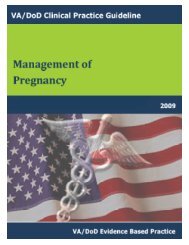DM Full Guideline (2010) - VA/DoD Clinical Practice Guidelines Home
DM Full Guideline (2010) - VA/DoD Clinical Practice Guidelines Home
DM Full Guideline (2010) - VA/DoD Clinical Practice Guidelines Home
Create successful ePaper yourself
Turn your PDF publications into a flip-book with our unique Google optimized e-Paper software.
Version 4.0<br />
G. Determine and Document If Diabetes Mellitus Is Type 1 or 2<br />
OBJECTIVE<br />
<strong>VA</strong>/<strong>DoD</strong> <strong>Clinical</strong> <strong>Practice</strong> <strong>Guideline</strong><br />
for the Management of Diabetes Mellitus<br />
Determine if insulin is a necessary component of treatment for the particular patient.<br />
ANNOTATION<br />
Patients with type 1 <strong>DM</strong> are insulinopenic (i.e., virtually absent insulin secretion), often due to autoimmune or toxic<br />
(e.g., alcohol) destruction of the pancreatic beta cells. Patients with type 2 <strong>DM</strong> have underlying insulin resistance<br />
and relative insulin deficiency.<br />
Patients with type 1 <strong>DM</strong> may initially present with diabetic ketoacidosis (DKA). However it is not uncommon for<br />
these patients to present to primary care with hyperglycemia alone, without symptoms of ketoacidosis.<br />
In a primary care setting, the patient's age at the time diabetes is diagnosed, plus the BMI and level of urinary<br />
ketones, and autoimmune markers are usually sufficient to classify the type of <strong>DM</strong>. In case of uncertainty a<br />
consultation with specialty care may be considered.<br />
Table D4. <strong>Clinical</strong> Classification of <strong>DM</strong><br />
Likely Type 1 Indeterminate Likely Type 2<br />
Age < 30 years 30 - 40 years >40 years<br />
BMI < 25 BMI* 25 - 27 >27<br />
Urinary ketones Moderate to large Low to moderate None to low<br />
*For Asian/Pacific Islanders the BMI threshold should be 23.<br />
The increasing prevalence of obesity has translated to an earlier onset for type 2 <strong>DM</strong>. Therefore, using age alone as<br />
a discriminator for the diagnosis of type 1 or type 2 <strong>DM</strong> may be misleading.<br />
DISCUSSION<br />
Because patients with type 2 or initially indeterminate <strong>DM</strong> (sometimes referred to as “atypical”, “ketosis-prone”, or<br />
“Flatbush” diabetes) can present with ketoacidosis (especially with concomitant alcohol use) they should be<br />
reevaluated after stabilization to assess continued need for insulin therapy.<br />
Patients with type 1 <strong>DM</strong> require insulin and will develop ketoacidosis if not treated with insulin or if insulin<br />
requirement increases during stress. Patients with type 1 <strong>DM</strong> are generally more prone to develop hypoglycemia or<br />
ketosis, especially during times of stress.<br />
Patients with type 2 <strong>DM</strong> may need to be treated with insulin to improve glycemic control but will not usually<br />
develop ketoacidosis if they do not receive insulin. Patients with <strong>DM</strong> adequately treated with medical nutritional<br />
therapy (MNT), physical activity, oral agents, and/or injectable GLP-1 agonists or amylin analogs are classified as<br />
having type 2 <strong>DM</strong>.<br />
Diagnosis of Type 1 versus Type 2 diabetes in adults presenting with ketoacidosis is challenging, especially in noncaucasian<br />
patients. Studies with good representation of Hispanics and African Americans find as many as ~50%<br />
with ketoacidosis have Type 2 <strong>DM</strong> and many can eventually be weaned of insulin. Also, patients with a history of<br />
thyroid or other autoimmune disease and patients without a family history of Type 2 diabetes are more likely to have<br />
Type 1 diabetes.<br />
Module D: Core Page 20
















